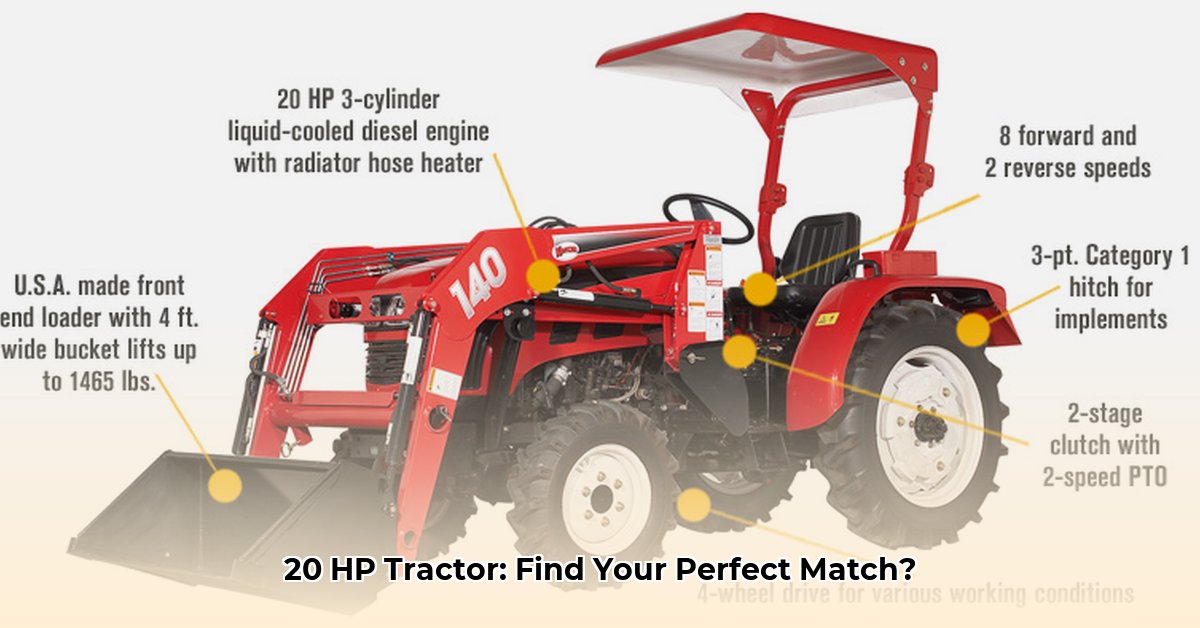
Shopping for a 20-horsepower tractor can be overwhelming. This guide simplifies the process, helping you find the ideal machine for your needs, whether you're a farmer, landscaper, or homeowner. We'll compare key features, analyze different models, and offer tips for maximizing value. For even more power, check out our guide on 24 horsepower tractors.
Understanding Key Features & Specifications
Before comparing models, let's define crucial tractor features. These specifications significantly impact performance and suitability for various tasks.
Engine Type: Diesel engines generally offer superior power and longevity, ideal for demanding applications. However, they often command a higher initial cost and require more specialized maintenance. Gasoline engines are typically less expensive to purchase and maintain, but they may lack the power and durability of diesel engines. Choosing between diesel and gasoline depends heavily on your budget and the intensity of your intended usage.
Transmission Type: Hydrostatic transmissions provide infinitely variable speeds, offering smooth control and ease of operation, particularly beneficial in tight spaces or around delicate landscaping. Gear transmissions, while requiring more manual shifting, deliver more power and efficiency for heavier tasks. Think of it like an automatic versus a manual transmission in a car; each has its advantages depending on your preferred driving style and the terrain you'll be traversing.
PTO (Power Take-Off) Horsepower: This specification indicates the power available to run implements like mowers, tillers, and loaders. PTO horsepower is usually slightly lower than the engine's total horsepower. A higher PTO horsepower rating ensures sufficient power for your attachments and a smoother operation. This rating helps you match the tractor to the specific work it will perform. For instance, a tiller needing substantial power would demand a higher PTO horsepower than a simple mower.
Three-Point Hitch: This system allows you to connect and utilize various implements. The three-point hitch's capacity—specified in pounds—directly relates to the weight of the attachments it can handle. Always check the lift capacity to ensure it accommodates your intended tasks. A higher capacity is advantageous for larger, heavier implements.
Hydraulics: The hydraulic system provides power to lift and control implements. Hydraulic flow rate (GPM, or gallons per minute) and lift capacity determine the system’s efficiency and capabilities. Higher GPM values usually mean more responsive and powerful hydraulic operation. The lift capacity directly dictates how much weight the hydraulic system can lift, influencing the types of implements you can use. A larger lift capacity is essential for heavier implements.
Comparative Analysis of 20 HP Tractor Models
Numerous 20 HP tractors exist, each with unique strengths and weaknesses. The following table provides a hypothetical comparison. Remember, actual models and pricing will vary by region and dealer. Always conduct thorough research before purchasing.
Don't forget to factor in the age of the tractor – a well-maintained used model can be more cost-effective than a brand-new machine, provided it is in excellent working order. Inspect any used tractor very carefully.
| Feature | Model X | Model Y | Model Z |
|---|---|---|---|
| Engine Type | Diesel | Gasoline | Diesel |
| Transmission | Hydrostatic | Gear | Hydrostatic |
| PTO Horsepower | 18 HP | 19 HP | 17 HP |
| 3-Point Hitch | 1,100 lbs | 1,000 lbs | 1,200 lbs |
| Hydraulics (GPM) | 7 GPM | 6 GPM | 8 GPM |
| Approximate Price | $10,500 | $9,000 | $11,800 |
Factors to Consider Before Buying
Before making a purchase, consider these crucial factors:
Budget: Determine a realistic spending limit. This significantly narrows your options and prevents overspending.
Intended Use: Define the tractor's primary functions. Small-scale farming demands different features than landscaping or light ground maintenance.
Terrain: Challenging terrains necessitate tractors with greater power and traction compared to level fields.
Maintenance: Assess your maintenance capabilities. Simple tractors often require less upkeep, while advanced models might require specialized servicing.
Dealer Support: Ensuring proximity to reliable parts and service providers is essential for minimizing downtime and associated costs.
Maintenance and Safe Operation
Regular maintenance is critical for longevity and efficiency. This includes routine oil changes, fluid level checks, and adherence to the owner's manual. Safe operation involves having proper training and utilizing necessary safety equipment. Never operate heavy machinery without appropriate safety precautions.
The Final Steps: Finding Your Perfect Tractor
Selecting the right 20 HP tractor requires thorough research and comparison. Compare specifications across various models, read reviews (being mindful of potential biases), and discuss your needs with experienced tractor owners. Test drive multiple models before making a final decision. Remember, the best tractor is the one that perfectly aligns with your specific needs, budget, and intended applications.